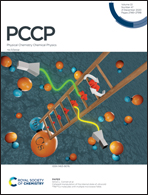Electronic and geometrical parametrization of the role of organic/inorganic cations on the photovoltaic perovskite band gap†
Abstract
Recent state-of-the-art analysis techniques have revealed the high sensitivity of new generation perovskite photovoltaics to the organic/inorganic A-cation's chemical composition and atomic configuration. Various studies have focused on an extensive list of potential candidates to find the best A-cation with optimum stability and efficiency output. Regarding the perovskite band gap, different characteristics such as cation size, constituent elements, atomic configuration, possible bonding potential and induced lattice distortion, have been considered to screen plausible A-cations. However, there is not a comprehensive and comparative framework for developing predictive models because of the strong correlation between governing parameters. In this research, we develop an innovative approach, using first principle methods, to parametrize the role of A-cation on the regulation of the well-known ABX3 perovskites band gap in a quantitative and comparative form. Parameters are introduced concerning the A-cation impact on the shared electrons of the B–X bonds, whose s and p states control the whole band structure. The A-cation induced geometrical distortion on the BX3 network, including the subsequent bond length and bond angle, are designated as indirect parameters; and its impact on the electronic states of B–X bonding through long range electronic interactions, is attributed as the direct role. Dissociation of correlative parameters is achieved by comparing the electronic properties of the BX3 network including and excluding their A-cation, as well as swapping different A-cations on the corresponding equivalent BX3 scaffolds. The governing mechanisms behind the direct/indirect contribution of Cs, methylammonium (MA) and formamidinium (FA) cations, regarding their impact on electronic charge density distribution and bonding tendency via the introduced parametrization, are investigated and discussed.



 Please wait while we load your content...
Please wait while we load your content...